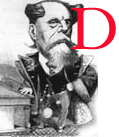 ickens had always objected to the "total abstinence" principle, preferring moderation to teetotalism. That notorious drunkard and Dickens illustrator George Cruikshank by 1847 had gone on the wagon with a vengeance, earning Dickens's ire in Examiner reviews of the temperance sequences The Bottle and The Drunkard's Children (1848), both of which he criticized by privately and publicly as rubbish — "an attempt by the weak-willed to make the temperate suffer for their inability to drink moderately" (Kaplan 227). Ten years later, in the protagonist of A Tale of Two Cities, however, Dickens acknowledges the disastrous effect that alcohol addiction can have on those who try to drink their way out of depression, even those as brilliant and heroic as Carton, with whom biographers Kaplan and Ackroyd contend Dickens closely identified himself.
ickens had always objected to the "total abstinence" principle, preferring moderation to teetotalism. That notorious drunkard and Dickens illustrator George Cruikshank by 1847 had gone on the wagon with a vengeance, earning Dickens's ire in Examiner reviews of the temperance sequences The Bottle and The Drunkard's Children (1848), both of which he criticized by privately and publicly as rubbish — "an attempt by the weak-willed to make the temperate suffer for their inability to drink moderately" (Kaplan 227). Ten years later, in the protagonist of A Tale of Two Cities, however, Dickens acknowledges the disastrous effect that alcohol addiction can have on those who try to drink their way out of depression, even those as brilliant and heroic as Carton, with whom biographers Kaplan and Ackroyd contend Dickens closely identified himself.
In fact, according to American biographer Fred Kaplan, Dickens pulled himself through to the end of his Anmerican lecture tour, like brilliant but alcoholic Sydney Carton (whom he had created nine years earlier) used up but determined to go on to the end, sustained by alcohol at every meal:
As the April [1868] departure date came closer, Dickens felt tired and acutely homesick. He felt "depressed all the time (except when reading)" and had lost his appetite. On reading days, at seven in the morning he had fresh cream and two tablespoons of rum, at noon a sherry cobbler and a biscuit, and at three a pint of champagne. Five minutes before his [evening] performance he had an egg beaten into a glass of sherry, during the intermission strong beef tea, and afterward soup, althogether not "more than half a pound of solid food in the whole four-and-twenty hours." [pp. 525-526]
Several of his short stories in Sketches by Boz relate the disastrous effects of alcoholism — "Gin Shops," "The Drunkard's Death," and "Making a Night of It" immediately come to mind — and of course this theme runs through a number of longer works. In The Christmas Books, and in particular in A Christmas Carol alcohol (taken in moderation, and in company) is benign, but in Hard Times Mrs. Blackpool's alcoholism, combined with her laudanum addiction, is anything but! Within the same text, we can have contradictory attitudes towards alcohol: for example, Dickens seems to tolerate as harmless dissipation the tippleing of Jerry Cruncher in A Tale of Two Cities, but condemns Jerry's wife-beating. The prototype of A Christmas Carol and The Chimes, "The Story of The Goblins Who Stole the Sexton" in the Christmas Number of The Pickwick Papers (Ch. 29) utilizes Gabriel Grub's alcoholism as a plot device in a manner reminiscent of Washington Irving's Rip Van Winkle, whereas "The Stroller's Tale" amounts to a polemic against drinking. Magwitch finds much relief in the brandy that Pip steals for him, but the savage Orlick's drinking at Satis House is suggestive of dereliction of duty. In "The Poor Man and His Beer" (All The Year Round, 30 April 1859) drinking is a harmless passtime, but Dickens always emphasizes the need for moderation. In his second American Tour, Dickens fortified himself at the intermission each night with a glass of champange, regarding a little alcohol as a useful stimulant.
References
Kaplan, Fred. Dickens, A Biography. New York: William Morrow, 1988.
Last modified 24 April 2006